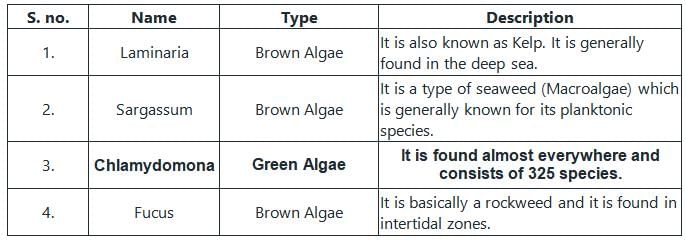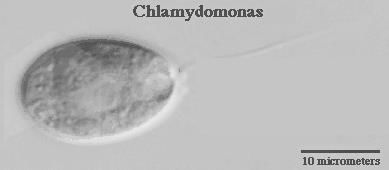NEET Exam > NEET Questions > Which of the following is an example of a gre...
Start Learning for Free
Which of the following is an example of a green algae?
- a)Laminaria
- b)Sargassum
- c)Chlamydomonas
- d)Fucus
Correct answer is option 'C'. Can you explain this answer?
Most Upvoted Answer
Which of the following is an example of a green algae?a)Laminariab)Sar...
Understanding Green Algae
Green algae are a diverse group of photosynthetic organisms primarily found in freshwater, marine, and moist terrestrial environments. They are known for their green color, which comes from the presence of chlorophyll.
Options Breakdown
- Laminaria:
- A type of brown algae, commonly known as kelp.
- It is characterized by its large, leafy structures and is not classified as green algae.
- Sargassum:
- Another brown algae species, often found floating in the ocean.
- It forms mats on the surface of the water and is not part of the green algae group.
- Chlamydomonas:
- A unicellular green algae.
- It belongs to the Chlorophyta division, showcasing a typical green color due to chlorophyll.
- Chlamydomonas is known for its flagella, which aid in movement, and its ability to reproduce both sexually and asexually.
- Fucus:
- A type of brown algae, commonly found along rocky shorelines.
- It has a distinct structure with air bladders for buoyancy, making it another example of brown algae.
Conclusion
Given the classifications, Chlamydomonas (option C) is the correct answer as it is a representative of green algae, while Laminaria, Sargassum, and Fucus are all brown algae. This distinction is important for understanding the diversity within algal groups and their ecological roles.
Green algae are a diverse group of photosynthetic organisms primarily found in freshwater, marine, and moist terrestrial environments. They are known for their green color, which comes from the presence of chlorophyll.
Options Breakdown
- Laminaria:
- A type of brown algae, commonly known as kelp.
- It is characterized by its large, leafy structures and is not classified as green algae.
- Sargassum:
- Another brown algae species, often found floating in the ocean.
- It forms mats on the surface of the water and is not part of the green algae group.
- Chlamydomonas:
- A unicellular green algae.
- It belongs to the Chlorophyta division, showcasing a typical green color due to chlorophyll.
- Chlamydomonas is known for its flagella, which aid in movement, and its ability to reproduce both sexually and asexually.
- Fucus:
- A type of brown algae, commonly found along rocky shorelines.
- It has a distinct structure with air bladders for buoyancy, making it another example of brown algae.
Conclusion
Given the classifications, Chlamydomonas (option C) is the correct answer as it is a representative of green algae, while Laminaria, Sargassum, and Fucus are all brown algae. This distinction is important for understanding the diversity within algal groups and their ecological roles.
Free Test
FREE
| Start Free Test |
Community Answer
Which of the following is an example of a green algae?a)Laminariab)Sar...
The correct answer is Chlamydomonas.
- Chlamydomonas is found in stagnant water and on damp soil as well as freshwater, seawater, and even in snow.
- About Chlamydomonas-
- Class: Chlorophyceae
- Order: Chlamydomonadales
- Scientific name: Chlamydomonas
- Phylum: Chlorophyta
- Higher classification: Chlamydomonadaceae



|
Explore Courses for NEET exam
|

|
Question Description
Which of the following is an example of a green algae?a)Laminariab)Sargassumc)Chlamydomonasd)FucusCorrect answer is option 'C'. Can you explain this answer? for NEET 2025 is part of NEET preparation. The Question and answers have been prepared according to the NEET exam syllabus. Information about Which of the following is an example of a green algae?a)Laminariab)Sargassumc)Chlamydomonasd)FucusCorrect answer is option 'C'. Can you explain this answer? covers all topics & solutions for NEET 2025 Exam. Find important definitions, questions, meanings, examples, exercises and tests below for Which of the following is an example of a green algae?a)Laminariab)Sargassumc)Chlamydomonasd)FucusCorrect answer is option 'C'. Can you explain this answer?.
Which of the following is an example of a green algae?a)Laminariab)Sargassumc)Chlamydomonasd)FucusCorrect answer is option 'C'. Can you explain this answer? for NEET 2025 is part of NEET preparation. The Question and answers have been prepared according to the NEET exam syllabus. Information about Which of the following is an example of a green algae?a)Laminariab)Sargassumc)Chlamydomonasd)FucusCorrect answer is option 'C'. Can you explain this answer? covers all topics & solutions for NEET 2025 Exam. Find important definitions, questions, meanings, examples, exercises and tests below for Which of the following is an example of a green algae?a)Laminariab)Sargassumc)Chlamydomonasd)FucusCorrect answer is option 'C'. Can you explain this answer?.
Solutions for Which of the following is an example of a green algae?a)Laminariab)Sargassumc)Chlamydomonasd)FucusCorrect answer is option 'C'. Can you explain this answer? in English & in Hindi are available as part of our courses for NEET.
Download more important topics, notes, lectures and mock test series for NEET Exam by signing up for free.
Here you can find the meaning of Which of the following is an example of a green algae?a)Laminariab)Sargassumc)Chlamydomonasd)FucusCorrect answer is option 'C'. Can you explain this answer? defined & explained in the simplest way possible. Besides giving the explanation of
Which of the following is an example of a green algae?a)Laminariab)Sargassumc)Chlamydomonasd)FucusCorrect answer is option 'C'. Can you explain this answer?, a detailed solution for Which of the following is an example of a green algae?a)Laminariab)Sargassumc)Chlamydomonasd)FucusCorrect answer is option 'C'. Can you explain this answer? has been provided alongside types of Which of the following is an example of a green algae?a)Laminariab)Sargassumc)Chlamydomonasd)FucusCorrect answer is option 'C'. Can you explain this answer? theory, EduRev gives you an
ample number of questions to practice Which of the following is an example of a green algae?a)Laminariab)Sargassumc)Chlamydomonasd)FucusCorrect answer is option 'C'. Can you explain this answer? tests, examples and also practice NEET tests.

|
Explore Courses for NEET exam
|

|
Signup for Free!
Signup to see your scores go up within 7 days! Learn & Practice with 1000+ FREE Notes, Videos & Tests.


















